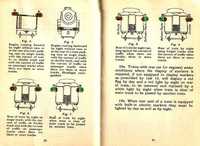"Régebben nézegettem BN-es videókat, de nem emlékszem, hogy villogó ditchlight-ot láttam volna.
De mintha a régebbi képeken nem is láttam volna a mellgerenda felett elhelyezett lámpákat, nem lehet, hogy csak később hozták/jött "divatba"?"
A ditch light-ot tudtommal Kanadában vezették be először a 70-es évek közepén. Ott nem villogott és most sem villog. Mások valószínűleg ezt vették át, tehát eleinte szerintem ott sem villogott. (Az említett cikk szerint mindenféle variációval kísérleteztek és 1996-tól vezették be a villogót. Ez egyrészt azt is jelenti, hogy a kísérleti időszakban mindenféle variáció előfordulhat, amúgy meg csak az USA-ra érvényes.)
Az elhelyezés is változik a mellgerenda alatt/fölött, a ditch light egymástól való távolsága stb. Eleve csak olyan gépekre teszik, amelyek vonalon szolgálnak, tehát a tolatószolgálatosokon valószínűleg nincs.
"Mostanában láttam (vagy figyeltem meg) olyan fotókat a 70-es évekből, ahol a classification light fehéren világított, de ugye mindig csak az első gép eleje látszott, a hátulja nem, a mögöttes gépeken nem világított."
A CP yahoo group-on azt válaszolták, hogy csak az első gép elején világít a classification light. Emellett nappal zászló is volt (fehér vagy zöld), mert napfénynél a lámpa rosszul látható.
"A number board közötti - iker - fényszóró(k)nak van valami neve?"
Szerintem simán "headlight"
---------------------
Néhány konkrét válasz, persze CP specifikusak:
Eegy classification light + zászló:
"Hello Gyorgy, some locomotives had a single light inside and a single lens
outside with red and green discs that could be placed between them. The flags
were used in daytime because the lights were not bright enough to be seen in
daylight.
Don Thomas"
-----------
Hol világit?
"The front lights would be lighted green or white if necessary. The rear lights
would not be lit unless the engine was running by itself, then the rear lights
would be red."
--------
A modern mozdonyokon miért nincs classification light?
"The current operating rules don't have extra trains or extra sections, so the
lights and flags aren't necessary."
-------
Válasz arra, hogy most miért nem látni hátul vörös lámpát?
"When locomotives are running as light engines (with no freight or passenger
cars), the rear headlight will be turned on at the dim setting. When the rear
of the train is a locomotive (part of a distributed power set), either the
headlight is on dim, or there may be the standard FRED hung on the rear coupler
as if it was a regular car.
John"
(A dim a csökkentett fényerőt jelenti.)
--------
Ez meg egy hosszabb válasz több kérdésre, pl. a külön felrakott marker light-ra:
"For CN and CP, marker lights had three green lenses and one red lens. The
marker lamp could be rotated on a bracket. Normally the red lens would face the
rear, but when the train was in a siding and clear of the main track waiting for
an overtaking train, both lamps would be rotated to show green to the rear.
In certain cases where there were two or main tracks the rules did require one
to be red and the other to be green facing the rear. These however were very
special situations, mostly when running against the current of traffic on double
track. Much of Canadian railways were single track, and there were extremely
few places with more than two main tracks.
You will notice that the rules dealt only with the signal shown to the rear.
Modern day operations have eliminated the whole issue. Red is the only colour
used, with a single flashing red light at the rear of freight trains. Passenger
trains might have a pair of red lights or the same device as the freights.
I can't comment about the SOO Line rules but most likely they were similar.
John"
A 2. bekezdéshez egy ábra a CN yahoo group-ról, itt láthatóak a normál két vörös mellett a vegyes vörös/zöld fények is:
